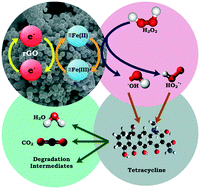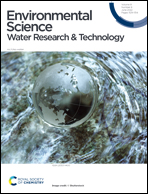Magnetite–reduced graphene oxide nanocomposite as an efficient heterogeneous Fenton catalyst for the degradation of tetracycline antibiotics†
Abstract
Magnetite nanoclusters supported on reduced graphene oxide (rGO) were successfully synthesized by a green solvothermal route. The simultaneous conversion of FeCl3 to magnetite and the reduction of graphene oxide (GO) to rGO, as well as magnetite anchorage on rGO sheets, are evident from the XRD, FTIR, XPS, Raman spectroscopy, SEM, SEM-EDS, and FE-SEM analysis results. The Fenton activity of the magnetite–rGO nanocomposite (with a GO weight % of 10) towards tetracycline (TC) degradation was exceptional. Under ideal experimental conditions, it removed 80% of the TC in 150 min. The magnetite–rGO nanocomposite is also a magnetically separable, reusable, and chemically and thermally stable catalyst. This study found the predominance of surface-based heterogeneous Fenton activity with an insignificant contribution from other possible removal processes, viz. adsorption, and homogeneous Fenton activity. The scavenging study revealed that hydroxyl radicals (˙OH) played a significant role, followed by superoxide radicals (O2˙−) and surface-bound ˙OH. The HR-LC-MS analysis indicates the TC mineralization via ring-opening. A further enhancement in heterogeneous Fenton activity of the magnetite–rGO composite was observed under solar illumination. In addition, this promising heterogeneous Fenton system provided efficient TC removal and mineralization from domestic wastewater.

- This article is part of the themed collection: Best Papers 2022 – Environmental Science: Water Research & Technology


 Please wait while we load your content...
Please wait while we load your content...